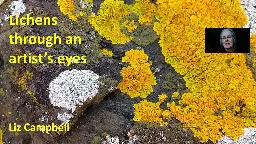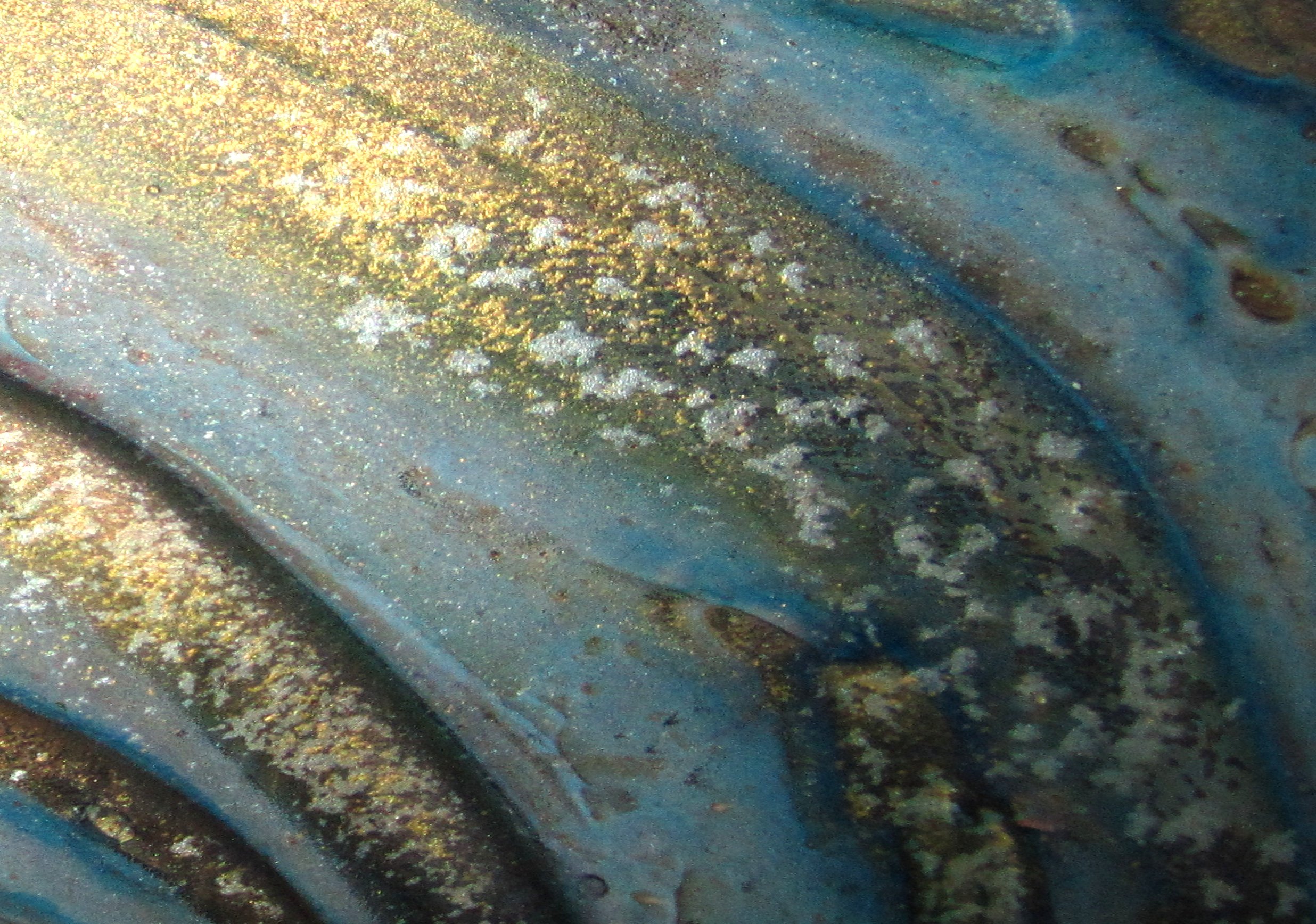
Natural Process Art
- "Every Breath is Beautiful" Lung surfactant photo by Benjamin Stottrup

2nd Place at the Biophysical Society's annual Art of Science competition in 2024 went to Benjamin Stottrup for this stunning image - "Every breath you take is possible because of lung surfactant. Lung surfactant makes these intricate and beautiful patterns that vary with composition and surface pressure. This image was taken by confocal fluorescence microscopy. Sample composition is 9:1 (4:1 r:racDPPC):hexadecanol with 1.5 mol% dehydrocholesterol."
- Rodent optic nerve head - photo by Hassanain Qambari and Jayden Dickson

This image of a rodent optic nerve head showing astrocytes (yellow), contractile proteins (red) and retinal vasculature (green) by Hassanain Qambari and Jayden Dickson won first place at the 2023 NSW Photomicrography competition.
https://www.nikonsmallworld.com/galleries/2023-photomicrography-competition/rodent-optic-nerve-head
- What’s It like to Be a Giant Sequoia Tree?

YouTube Video
Click to view this content.
An art collective that creates immersive multimedia pieces about non-human subjectivity. I'm posting the TED talk bc when I looked, noting they had online seemed to be designed for online consumption, it's all exhibits. I hope one day they make work intended to be consumed at home and not just in a few galleries a world away. Their ideas/approaches seem very powerful.
- Lidar-Derived Aerial Maps Reveal the Dramatic Meandering Changes in River Banks Over Millennia

The processes of erosion and subsequent sediment deposition can produce some very intriguing and visually staggering imagery, whether on a small scale, or visible from satellites, as presented here.
Wherever there is nature, you will never be far from Art.
https://www.thisiscolossal.com/2023/10/dan-coe-lidar-rivers/
- *Winfrieda* by Susan Carlson :: A bit of a stretch for this community but the fur patterning is so amazing on this piece.

https://susancarlson.com/2023/10/19/susan-carlson-throwback-thursday-winfrieda-the-lace-polar-bear-returns-to-fly-on-the-wall/
See also:
The Animal Kingdom in Quilts and Textiles: https://www.neqm.org/animalia-details
- The best science images of 2023 – Nature’s pickswww.nature.com The best science images of 2023 – Nature’s picks
Cosmic dust, microscopic syrup, a flying gecko and more.
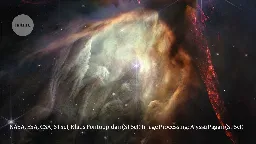
- Marbled paper, frosty fireworks among 2023 Gallery of Fluid Motion winnersarstechnica.com Marbled paper, frosty fireworks among 2023 Gallery of Fluid Motion winners
Annual showcase highlights "captivating science," "breathtaking beauty" of fluid motion.

- Spiral Jetty: 50 Years in an Ecosystem

One of the most amazing things about Art which is meant to change within an environment as the environment changes, is the cumulative effects that change can have, when viewed over a long period of time. This artwork was meant to archive that change, as that change transformed the work of art.
It's important to revisit works like these, to get in touch with the passing of time in beautiful new ways.
https://www.deseret.com/entertainment/2020/4/7/21207816/spiral-jetty-50-robert-smithson-nancy-holt-anniversary-dia-umfa-great-salt-lake-landmarks-utah
- The Artwork That Took 30 Years and 200 Acres to Createwww.smithsonianmag.com The Artwork That Took 30 Years and 200 Acres to Create
Renowned artist Anselm Kiefer goes big with his massive installation in southern France
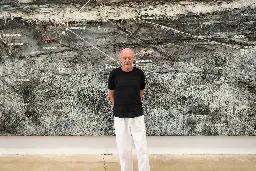
- Do we need more soil art?matthiasrillig.substack.com Do we need more soil art?
With soil not inherently aesthetically attractive, we need all the help we can get
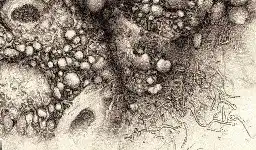
- "Surface of titanium carbide crystal" by Dr. Lynn Boatner and Hu Longmire

This image was captured by Differential Interference Contrast by Dr. Lynn Boatner et al of the Oak Ridge National Laboratory in Oak Ridge, Tennessee, USA for the 2003 NSW competition, where it placed 15th. ...But of course I will hone in on it because it looks so much like a landscape!
https://www.nikonsmallworld.com/galleries/2003-photomicrography-competition/surface-of-titanium-carbide-crystal
- "The Phoenix" by Loren Hall

This painting was a salvage operation, from the moment when I discovered that my gesso had been replaced by a cheap impostor wearing the same bucket. The gesso cracked and fell away from the masonite, and I almost gave up on this painting - and painting in general. I didn't though, and just applied more gesso over what was left in this painting. The end result was definitely an interesting surface to apply pigment to, resembling a rocky coastline where a few puzzle-pieces of gesso held on.
My work has always attempted to echo nature, by applying some of the same processes that nature uses - in this case sediment deposition (in addition to fractal field applications), to reproduce alluvial fans, river deltas, and other geological features often found in the natural world.
Pigment is applied in a highly aqueous state by pouring it over a level painting like flood waters, which move over some areas quickly, and others more slowly. Depending on the pigment grain, the individual particles settle at different rates, collecting on the surface in differing concentrations. Just like in nature, this liquid collects from these "rivers and streams" into larger "lakes and seas", which sometimes take days to dry completely in the sun.
Each consecutive layer interacts in unexpected ways with the previous, resulting in a work that was painted by nature. As the artist I just facilitated the various processes it needed to accomplish its magic.
https://blog.yourdesignjuice.com/2021/11/an-artists-life-by-loren-hall/
- "Thin slab of Brazilian agate" by John I. Koivula

Submitted to the Nikon photomicrography competition in 1990, this entry won 4th place. In addition to just being a lovely piece, it has the distinctive signs of nature repeating herself - this time in the form of an alien desert landscape! And THAT, is a tell-tale sign that some natural process art is afoot!
https://www.nikonsmallworld.com/galleries/1990-photomicrography-competition/thin-slab-of-brazilian-agate
- Elin Thomas exhibition pieces, Pt. 2

The more I look at these, the more I'm taken by the feeling that what I'm looking at was not only formed by nature, but colonized by nature in a seemingly random way that has a mind of its own - apart from the artist. It is this "mind" that creates a lot of natural process art, and as an artist I can tell you that it is a joy and a wonder to work with, once you can forge a relationship with it.
I do not think that this particular artist copies mold colonial distribution exactly, mapping them all out using mathematical coordinates, but there's an overall feeling that says "this is natural", not a placement that feels labored over, or over-considered, and that requires an artist for which the natural world, its preservation and presentation, is more important than the ego, or the will of the artist.
I can highly respect that.
https://www.elinthomas.com/section371257.html
- "Carbon Nanodiamond Particles Alter the Morphology of DPPC Monolayers" by Prajnaparamita Dhar

This entry from the 2013 competition won first place, and in spite of its rather pixelated appearance, it is indeed fascinating, and visually intriguing! It was created by using fluorescence microscopy imaging, and shows "alterations in the morphology of Dipalmitoylphosphatidylcholine (DPPC) monolayers at an air/water interface due to extended exposure (8 days) to carbon nanodiamond particles. The images show discrete dark liquid condensed phase domains in a continuous bright liquid expanded phase due to interactions with the carbon nanoparticles."
...I couldn't have said it better, myself.
https://www.biophysics.org/awards-funding/image-contest#/
- "Crystals evaporated from solution of magnesium sulfate and tartaric acid" by Richard H. Lee

This image won first place in the NSW photomicrography competition, in 1990. Looking at the other entries from that year, the competition seemed to be fairly stiff. I will most definitely be posting some more images from that year!
This particular image was produced by Richard H. Lee of Argonne National Laboratory in Argonne, Illinois, and looks for all the world like a fish rising to the surface of the water to me.
https://www.nikonsmallworld.com/galleries/1990-photomicrography-competition/crystals-evaporated-from-solution-of-magnesium-sulfate-and-tartaric-acid
- "A Morphological Examination of Programmed Cell Death" by Eammon Kennedy

This striking image, produced by Eammon Kennedy of Notre Dame, is a composite of six Atomic Force Microscopy (AFM) topographs of cancer cells. Programmed cell death (apoptosis) has been induced by laser irradiation.
This image won 2nd place in The Biophysical Society's annual Science of Art competition, in 2017.
https://www.biophysics.org/awards-funding/image-contest#/
- Elin Thomas exhibition pieces, Pt. 1

Elin Thomas has used the "mold and lichen" motif on everything from clothing to book covers and more, but her exhibition pieces are arguably her most intriguing, because rather than using these individual elements as an accent, or simple adornment, these larger pieces capture the random distribution of colonies over an area, which to me is every bit as fascinating and visually captivating as the formations themselves.
https://elinthomas.bigcartel.com/
- The Scientific Illustrations of Ernst Haeckel

Are scientific illustrations natural process art? That is up for debate, but in my opinion any art that is based on direct observations of nature can be considered natural process art, so long as the intent is not only to illustrate an idea, or present a thing, but present it in an aesthetic, visually appealing way. The intent is also to create something beautiful, not just educational, or scientifically accurate.
The work of Ernst Haeckel definitely fits into this category. Not only does it offer an accurate reporting of biological forms in their various environments and life cycles, but does so in a staggeringly beautiful, graphically intriguing manner.
All work from "Kunst Formen der Natur".
https://ucmp.berkeley.edu/history/haeckel.html
- "Appendages of a common brine shrimp" by Dr. Igor Siwanowicz

The intricacy and color depth of this one just floor me... It came in 8th place in the Small World competition in 2014, but if you ask me it should have ranked higher, in spite of the high quality of the competition!
https://www.nikonsmallworld.com/galleries/2014-photomicrography-competition/appendages-of-a-common-brine-shrimp
- ASM Video Tutorial: How to Create Agar Art with Living Microbes

This video was produced by the same organization that brings us their annual agar art contest each year! I was fascinated to learn how this is done, and hopefully the process will intrigue you, as well!
https://www.youtube.com/watch?v=LXwxU-nIcDY&pp=ygUIYWdhciBhcnQ%3D
- "Harvest Season" Agar Art by Maria Eugenia Inda, Ph.D.

If you had told me just a couple years ago that people painted with microbes, I would probably tell you to go easy on the LSD. But no... this really happens, and it's not an accident in the back of someone's refrigerator - it's completely intentional, and beautiful!
As the artist you are actually growing the pigment!
This entry was from the first ASM Agar Art contest in 2015, and placed third!
https://asm.org/Events/ASM-Agar-Art-Contest/Previous-Winners/2015
- "Hofmannophila", scales under the microscope

I was looking at an unfortunate House Moth (Hofmannophila pseudospretella) that drowned in a flower vase under the microscope.
Since it had been floating in the water for a while, many of its scales easily detached and floated away from its wings and formed multiple clusters nearby, creating what I thought looked like a rather picturesque scene. This community immediately came to mind and so I decided to take some photos :)
Here is another frame:
And a view of the assembled wing:
- More Ni9W under confocal microscope

I really like the patterns created here. It looked like glitter to the naked eye. It was recristallized at over 1000 °C for an extended amount of time in a nitrogen atmosphere. Some crystals grew faster swallowing others in the process.
- Should "Eco Graffiti" change its name?

While the roots of this term definitely reside in street art - that is, art which is not officially endorsed, funded, or sanctioned - it is often a welcome beautification of otherwise drab, dreary places with a bit of natural magic. If the moss might be there naturally anyway, why not present it in an appealing and interesting way?
Not only that, but studio artists have taken up the green mantle themselves, opening up the arena to all sorts of new interpretations, perspectives, and messages.
These works, without regard to their creation or intention, are all related by more than chlorophyll, they are all expressing the idea that nature is a bridge between humanity and our aspirations - with it, by it, and through it, we can achieve anything.
It is also temporary - expressing that we only have a brief window of opportunity to view this perspective from.
- "Bridge of Chaos" Fractal fields by Derek K. Nielsen (2016)

cross-posted from: https://mander.xyz/post/2058240
> Older work by Derek Nielsen, but one of my favorites! The depth and delicate intricacy of his fractal field patterns just captivate me. Couple them with some well-placed color, and we have a winner. If you like his work then please check the link below! > > ! > > https://www.instagram.com/derekknielsen/?hl=en >
- "Ice Crystal Growth in Microfluidics" by Graham Johnson

I don't know about you, but this is what I need more of right now in this weather - visions of very, very cold things! This one in particular is interesting because it is an image taken during research onto ice-binding proteins. The temperature is suddenly lowered, to study the dendritic crystal growth which happens in an enclosed matrix.
https://www.biophysics.org/awards-funding/image-contest#/
- "Composition from wind-blown sand on concrete 2" by Brian Canavan

Are these windswept sand dunes, as seen from 1,200 feet above the surface of the planet, or are these formations inches across? It's often hard to tell with natural processes, and that ambivalence lends itself to some wonderful new perspectives.
https://mastodon.scot/@ijustmightbe/110853173157776947
- Crocheted Coral Reef pt. 3

Though this science-based project originated in one place with two people, it has now grown to cover many more places, and even more people! It takes many hands to make these reef components, and those hands need many hours to make all of the stitches required to produce these displays.
Next time we'll cover the ecological and environmental aspects of these works! Satellite Reefs
- "Ocean Siren" - Sensory Sculpture by Jason deCaires Taylor

This is not meant to warn ships away from the Great Barrier Reef in Queensland, Australia, as its size and location prohibit that function. It's main function is a sensor for water temperatures in the area. The colors of the various LED's within indicate ocean temperatures, and are a beautiful way of indicating important ecological metrics, especially in relation to the coral reef it protects.
https://www.underwatersculpture.com/projects/ocean-siren/
